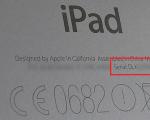How to set up cable internet on windows xp. Creating a PPPoE connection Windows XP. Cable connection
1. Click Start, select the Control Panel menu item;
2. At the top left, select Switch to Classic View;

3. Click on the Network Connections icon;

4. Right-click on the Local Area Connection icon; and select the Properties menu item;

5. Uncheck the box next to Internet Protocol TCP / IP; and with When connected, display the icon in the notification area; and click OK;

6. Confirm the disabling of the components by clicking the Yes button;

7. In Network tasks; select the Create a new connection item;

8. The New Connection Wizard will start; click the Next button;

9. Leave the Connect to the Internet item; and click Next;

10. Select Set up connection manually; and click Next;

11. Select Via broadband, prompting for a username and password; and click Next;

12. Enter the name of the omkc service provider; and click Next;

13. Enter your username, password and password confirmation (password and confirmation must match, all fields are case-sensitive) and click Next;

14. Check the Add shortcut to desktop checkbox; and click the Finish button;

15. To connect to the Internet, click the Connect button;

Setting up the Internet in Windows XP is no different in its complexity. This applies to both wired and wireless connections. In the first case, the parameters are set in the section "Network connections", which is located in the Control Panel. In the second, everything is done with the loading of drivers, if they are initially absent from the system.
Connection setup
If the setting is for a wired connection, then you need to know certain network parameters. But this does not apply to the case when the computer is connected to the Wi-Fi router via a cable. This is not the case with the wireless network.
If a laptop with pre-installed Wi-Fi, then you just need to download the necessary drivers and connect to your home network. The procedure for the discrete adapter is the same. For owners of 3G / 4G modems it is even easier: just download the software you need, enter the SIM PIN-code, if required, and activate the connection.
Method 1: Direct Wired Connection
Open the menu "Start" and click on "Control Panel"... There, switch to the classic view, if there is such a possibility. Expand an item "Network connections".
Several devices can be displayed in the window. Find the one that has a signed status "Connected", and double click on it. There select the item with the name "Internet ProtocolTCP /IP " and open its properties.  Set the checkboxes in the checkboxes to the manual input mode, and then specify the settings for your network. Button "OK" will be a confirmation of your actions.
Set the checkboxes in the checkboxes to the manual input mode, and then specify the settings for your network. Button "OK" will be a confirmation of your actions.
Note: the Internet may not work even with the correct parameters. This is because your connection is set to a network device with a differentMAC address. In this case, you need to call the provider and describe the problem, technical support will fix everything within a few minutes.
Method 2: Wired connection via Wi-Fi router
Now let's figure out how to connect the Internet with a cable through a router to Windows XP. In this case, no detailed configuration is required, since the device parameters have already been set as required. All that remains is to connect it to your computer or laptop via an Ethernet cable.
Important: two cables are initially suitable for the router: one for power supply, the second for the Internet. You don't need to touch them. Plug the third into one of the free numbered slots, and then plug it into the network adapter on your computer.
When the physical connection is complete, all that remains is to configure the computer to work correctly. Most likely, even this is not required, the Internet will immediately start working. If this does not happen, then follow these steps:

Close the settings window and go to any program that works with the Internet, for example, a browser. There you can check the connection status. If the instruction does not work, then there is a problem with the settings of the router.
Method 3: wireless network
Setting up Wi-Fi in Windows 7, as well as an external modem, is different from a wired connection. First you need to find and install drivers for the device. Usually they are included in the package, also available for download from the official website. A shortcut to enable 3G / 4G is located on the desktop. Open it and then click the connect button.
The connected Wi-Fi will be displayed in the tray. Click on its icon, select your home network and enter the access code for it.
Setting up an Internet connection under Windows XP (2000)
Detailed connection setup.
Attention! The configuration is done with administrative rights. All screenshots are presented for Windows XP with a classic view of menus and panels. The configuration of other versions of Windows is the same, except for the names of some shortcuts, which is reflected in the comments.
This completes the setup of your computer's connection to the free d om local network! You can continue to configure your Internet connection. If the local area connection is disabled, you must enable it by right-clicking on it and clicking Turn on... Otherwise, you will not be able to access the Internet.
Note. With a configured local network connection, access to the local resources of the Freedom network and the statistics server is possible.
The next step is to create a VPN connection. Configuring a VPN connection in Windows XP must be performed under a user account with administrator rights. If you are logged on to Windows as a non-administrator user, log off that user and log on to Windows as an administrator (or as a user with administrator rights).
1. Create a VPN connectionFirst save to desktop and run it. You must agree with the proposal to make changes to the register by clicking the "Yes" and "OK" buttons:


If difficulties arise, the necessary changes to the registry can be made through the command line ( Start, Execute, dial cmd, press OK). In the command line, you need to type (or first copy to the buffer :)
REG ADD HKEY_LOCAL_MACHINE \ System \ CurrentControlSet \ Services \ Rasman \ Parameters / v ProhibitIpSec / t reg_dword / d 00000001
If you receive a message that the operation was completed successfully, continue with the configuration.
Be sure to restart your computer!
Then start the New Connection Wizard. To do this, click the "Start" button on the taskbar, in the menu that opens, select "All Programs" (or just "Programs" if you reconfigured the standard view of the start menu), then "Standard", "Communication", "New Connection Wizard" (fig. 1).

Rice. one
The first dialog box of the New Connection Wizard tells you what you can do with it. To start creating a connection, click the "Next" button (Fig. 2).

Rice. 2
In the next window of the New Connection Wizard, you need to select the type of network connection. In our case, you need to select the item "Connect to the network at the workplace" (Fig. 4). Click the Next button to proceed with the configuration.

Rice. 3
In the next window, you need to select a connection method. As a connection method, you need to specify the item "Connecting to a virtual private network" (Fig. 5). Click the Next button to proceed with the configuration.

Rice. 4
In the next window, you need to enter a name for the connection being created. The name can be anything, for example "IC" (fig. 6). Click the Next button to proceed with the configuration.

Rice. 5
A window in which you are asked to select whether you need to establish another preliminary connection before establishing this connection will be displayed if you have already created a network connection for a modem connection. If such a window appears, then you need to select the "Do not dial the number for preliminary connection" item and click the "Next" button.

Rice. 6
In the next window of the New Connection Wizard, you must enter the name or IP address of the VPN server.
Specify as name L2TP.freedom(fig. 7). Click the Next button to proceed with the configuration.

Rice. 7
In the last window of the New Connection Wizard, you can specify that you want to create a shortcut on the desktop for the created connection. To create a shortcut, the corresponding checkbox must be enabled (Fig. 8). To complete the creation of the connection, click the "Finish" button.

Rice. eight
Call the properties of the VPN connection. To do this, click the "Start" button on the taskbar, in the menu that opens, select the "Connection" item. In the menu with the list of connections, right-click on the created connection and in the context menu that opens, select the "Properties" item (Fig. 9).

Rice. 9
A dialog box with several tabs will open. First select the tab<Сеть>(fig. 9a), set the VPN Type: L2TPIPSecVPN

Rice. 9a
Below, among the components used by this connection, highlight the line<Протокол интернета(TCP/IP)>and press the button<Свойства>... Write down the addresses of the DNS servers in accordance with the figure (Fig.9b):

Rice. 9b
Then select the tab<Безопасность>, install<Обычные параметры>and<Безопасный пароль>, in accordance with the picture, uncheck all the boxes:

Rice. 10
3. Connection
In order to establish a VPN connection, click on the shortcut of the VPN connection (it is assumed that when creating the connection, you have enabled the checkbox for creating a shortcut on the desktop). A window for entering a username and password will open. In the corresponding input fields, enter the username and password for connecting over the network (the same as for authorization). For convenience, you can choose<сохранить имя пользователя и пароль>... Click the "Connect" button (Fig. 11). After the connection is established, the connection icon will appear in the system tray (icon area).

Rice. eleven
If you want to disconnect the VPN connection, you need to right-click on the connection icon and select the "Disconnect" item in the context menu that opens (Fig. 12).

Rice. 12
To view the pages when connecting using the created VPN connection, you need to open Internet Explorer, go to Service, Internet options, Connections, make sure VPN is selected as default and put a period in front of it.
To enter the statistics server, being disabled in the presence of debt, for example, to activate an Internet card, you need to set a point near Never use... After activation is marked again Always use the default connection... In addition, it allows Internet Explorer (IE) to be sent to the statistics server with certain settings. When using IE6 with default settings, the statistics server opens without problems. If IE7 is installed and the statistics server does not open, you need to go to IE in Service, Internet Options, Advanced, press the button Reset... After a factory reset, you need to restart Internet Explorer.
Note. Sometimes, when creating a VPN connection, when choosing a connection method, connections are not active. In this case, you need to check and start the following services:
("Start" - "Control Panel" - "Administrative Tools" - "Services"):
"Telephony";
Remote Procedure Call (RPC);
"Remote Access Connection Manager".
We are waiting for your feedback and suggestions on the forum.
Setting up a wifi (Wi-Fi) connection in Windows XP, the procedure is a little more complicated than in Windows 7. WiFi connection is set up in just a minute, and this article will describe the setup process step by step with illustrations.Important! Windows with different service packs support different security protocols! Windows XP SP2 does not support WPA2 security protocol! First WPA only. Thus, if a problem arises when connecting, you need to look at the version of Windows XP, as well as the security protocol that the access point uses.
Similar articles for other operating systems:
WiFi setup in Windows XP
Setting up a WiFi connection in Windows XP is a snap. In the tray, on the "Wireless network" icon, you need to right-click and then, from the menu, select the "View available wireless networks" command:

The same can be done if you open Windows Explorer, then open "My Computer - Control Panel - Network Connections" in Explorer:

The same can be done if you open the "Start - Settings - Network Connections" menu:

After that, a window will open in which you need to select the desired access point then click the "Connect" button:

After that, a window will open in which you need to enter the password for the access point. Unlike Windows 7, where you can see the password characters, here you can control the correctness of the password only at the level of comparing two attempts. Then in this window you must enter the password twice:

Then you need to wait:

Finally, the connection is established:

Manual configuration of a wireless WiFi connection
If you need to change the WiFi connection settings, you can do this by opening the properties of this connection:



How to use wifi
Using wifi is very easy. After you have created a connection, you can turn it on and off through the network icon in the tray. 
However, you need to understand that the ability to use wifi strongly depends on external factors. Since the radio signal is affected by the external environment. Obstacles such as walls, ceilings, and floors weaken both the signal of the access point and the signal of the client device. Windows shows the signal strength from the access point in sticks. The pictures at the beginning of the article show the signal level in one or two short sticks. This is a very weak signal. with such a signal, you will most likely not be able to use the Internet.
There are programs that show the signal level in numbers - dBm, for example 60 dBm or 40 dBm. The larger this number, the weaker the signal - a good signal is a figure less than 50 dBm. However, you need to understand that the accuracy of such numbers varies depending on the adapter and the driver of this adapter. Under the same conditions one adapter can show for example XP1 dBm, and another adapter 82 dBm.
In addition to passive barriers, the quality of wifi signal transmission can be adversely affected by sources of electromagnetic radiation. So, even if you have the best wifi adapter installed on your laptop, this does not mean that you can always use the Internet via wifi.
In a bad signal situation, using an adapter with an external antenna can help. For example, the TP-Link TL-WNXP22N / C USB wifi adapter is equipped with an external antenna. Moreover, it is removable and, if necessary, can be replaced with another one with a high gain.
What does the presence of an external antenna give? Continuing the same example - under equal conditions - the same access point, the same time and place of connection, the presence of passive barriers between the access point and the client - as a result, a weak signal in both directions:
- The internal "native" wifi adapter of the laptop connects to the access point, but practically does not make it possible to use the Internet due to low speed and frequent drops.
- TP-Link TL-WNXP22NC with its own antenna provides a stable Internet connection at a good speed.
If wifi does not work on Windows XP
If your computer does not have a "Wireless Network Connection", the reason may be one of the following:
- You have Windows XP SP2, and the access point is configured for WPA2 security. You need to either install SP3 or reconfigure the access point to WPA.
- There is no wifi adapter on your computer at all. You can find out through the Device Manager. There must be a wireless network card in the device list.
- Your computer has a wifi adapter, but it is disabled. For example, many laptops have buttons to turn off the wifi adapter. It can be a separate button or one of the F buttons in combination with the Fn button. If the wifi adapter is built into the motherboard, it can be disabled in the BIOS.
- There is an adapter, but no drivers are installed on it, in this case it will appear in the list of devices as an unrecognized device.
- The adapter is there, but it is disabled by software.


If there is a "Wireless Network Connection", it shows a list of networks, but it cannot connect to the desired network, then the reason may be that:
- The signal between your adapter and the access point is too weak. Long distance, thick walls, etc. Moreover, the signal level of the access point may be decent, but the signal of your adapter does not "finish off" the access point. Because the signal of the adapter is generally weaker than the signal of the access point. Especially if the adapter is built-in, such as in a laptop.
- You entered an incorrect password. This is especially true for Windws XP because the password characters cannot be seen there.
If the connection to the access point is established, but the Internet does not work, then the reasons may be:
- The Wifi router (access point) is not connected to the Internet. For example, a technical failure with a provider, or a lack of funds on your account with a provider.
- Technical failure of the provider's DNS servers.
Home WiFi networks
WiFi security
Since when using wifi, all information is transmitted over the radio wave, this makes wifi networks much more vulnerable than wired networks. The fact is that the radio signals sent by the access point (wifi router) and devices that are connected to the access point are available for interception by any similar device that is within the "audible" radius of the access point or from the client of this access point. That is, intercepting network traffic becomes very simple, affordable and invisible. And intercepting network traffic allows you to collect information necessary to attack a wifi network. As more and more hotspots become, wifi increases and the number of people who want to "hack" the wifi network increases.
The most common motivation for hacking wifi hotspots is connecting to the internet via wifi for free. A fairly common picture today - you have a wifi router installed in your apartment and not only your devices, but also the computer of one of your neighbors are connected to it. You pay for the Internet, and your tech-savvy neighbor gets the Internet for free.
But "stealing" the Internet is not the only reason wifi networks are "hacked". The fact is that if an attacker gains access to your access point, he can get access to all devices that are connected to your wifi router through it. And this gives him the opportunity to steal your personal data. For example, passwords to mail, to Internet banks, your documents - in one word to everything you own.
Therefore, use wifi with caution. Here are some rules to follow.
Do not connect to open public wifi networks through a laptop on which you store valuable information. And if you need access to the Internet through open wifi networks, then use a firewall and antivirus on your laptop. It's even better if you install two operating systems on your laptop. One main, which will store all your valuable information. And the other is empty, just to access the Internet through open wifi networks.
If you use a wifi router at home or in the office, you need to correctly configure the wifi router:
- Use WPA2 security type.
- The password for protection must be long - preferably 50 - 60 characters, and must consist of an arbitrary set of characters. Password marina1234 very bad - it will be hacked in a few minutes. Password nvysue5XPk-sjehr)




